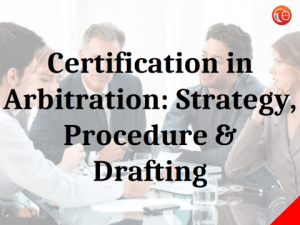
This article has been written by Dishani Dutta, pursuing a Certificate Course in Arbitration: Strategy, Procedure and Drafting from LawSikho.
Table of Contents
Introduction
In the modern era, where time is of the essence and energy is limited, parties to a contract anticipating arousal of dispute, are drawn to Alternate Dispute Resolution(ADR). The principle of an ADR is the parties’ liberty to select the arbitration mechanism that is deemed fit to cater for their requirements, at an elected seat of their choice, and empowers them to determine the substantive and procedural rules applicable for the resolution of their dispute. This party autonomy principle, in its various formulations, is universally acceptable to international instruments, case laws and statutes, and ensures that international commercial arbitration proceeds in accordance with the parties’ aim and aspirations. This article succinctly observes the validity of arbitration clause in an agreement, concurrently dealing with judgements on the presence of a hybrid arbitration clause.
Validity of clause in the arbitration agreement
By the expression “dispute resolution clause” it is referred to the contractual provisions by which parties specify the methodology of dispute resolution. These include arbitration, mediation and litigation through the courts (also known as a ‘jurisdiction clause’).
For an arbitration clause to be enforceable, parties’ intent to choose arbitration as an alternative dispute resolution forum must be affirmative.
From time to time the Indian judiciary has raised questions about the validity of the arbitration clause. Even if an arbitration agreement fulfils all the essential requirements of a valid contract, the way in which parties agree to arbitrate is contentious. While in several countries, the mandate of such agreement to be “in writing” is absent, the Indian act i.e. the Arbitration and Conciliation Act, 1996 mandates it. Therefore if an award is made pursuant to the oral agreement in Sweden, it cannot be enforced in Indian Court, though the foreign award is enforceable and executable (Section 47- 49).
The validity of an arbitration clause in an agreement was discussed in Smt. Manju Gupta & Ors. vs Shri Vilas Gupta & Ors. Any agreement not in writing or any dispute that is beyond the scope of the arbitration agreement between parties to a contract is considered invalid. The existence of the arbitration agreement does not hold credibility unless it is contractually valid.
In the case of Yashvant Chunilal Mody v. Yusuf Karmali Kerwala, the Bombay High Court held in its judgement – an arbitration agreement shall mandatorily be in writing according to Section 7(3) and the fact that the agreement is in writing shall be proved as per Section 7(4) of the Act.
What is meant by the hybrid clause?
If any of the essentials of a valid Arbitration clause is missing, the clause is labelled as Pathological–meaning, clause containing apparent defects that are likely to disrupt a smooth arbitration. Such clauses can potentially strife the whole duration of dispute resolution, ranging from jurisdictional scuffles to endangering enforcement of the award. It is likely to lead to prolonged arbitral proceedings, exceeding arbitration cost etc.
Autonomy of party is a crux of arbitration, which makes parties the true pioneer of an arbitral procedure. And it is on this variety that a hybrid arbitration clause is founded. A general hybrid arbitration clause is where the parties mutually confer on an arbitration institution to administer an arbitral proceeding deploying the rules of another arbitral institution.
In simpler words, A ‘Hybrid Arbitration Clause’ provides for one arbitral institution to administer an ad hoc arbitration under the procedural rules of another arbitral institution.
Such clauses can be considered as one kind of pathological arbitration clauses, that is likely to jeopardise the enforceability of the arbitration clause/agreement due to its weak foundation and uncertainty of draft.
The intervention of another administrative institution, in the presence of one referred in the antecedent dispute resolution clause of any contract, makes the dispute resolution procedure hybrid in nature. This type of hybrid dispute resolution procedure also implies a course of action driven by elements of both mediation and arbitration (both are alternative dispute resolution mechanisms).
Avoiding hybrid clause
Is it possible to evade a defective clause? Yes.
Any erroneous and uncertainty regarding an arbitration clause can be evaded if these basic yet key points are kept in mind –
- Adhere to the conventional and orthodox form of the Arbitration clause.
- Avoiding wild drafting, stick to a model clause.
The suggestions are precautionary in nature, as it relies upon careful construction of the agreement to contract. To ensure that a smooth process of arbitration ensues, the drafting of the Arbitration clause must be impeccable. Professor Benjamin G. Davis is of the opinion that for a drafting team, the tools of interpretation must be at their disposal.
Why should such a clause be avoided?
- Ill drafted clauses can drive up the cost of arbitration, exposing both parties to suffering.
- Without any valid and enforceable Arbitration clause, it may be difficult to constitute an Arbitral Tribunal or determine jurisdictions.
- Litigation relating to the scope, validity and effectiveness of such arbitration clauses is likely to rise.
- It is essential for the parties to resolve the issue of governing law beforehand to avoid wasting time when a dispute arises. Therefore the parties need to pinpoint a rule of a single arbitral institution. It is suggested that the choice of Jurisdiction be made after considering which one is generous in their interpretation. It is self-explanatory that when the parties are unsettled, they will be guided by one of the many arbitration organizations they have chosen. Following are the most frequently approached:
- American Arbitration Association’s International Centre for Dispute Resolution (ICDR)
- International Court of Arbitration of the International Chamber of Commerce (ICC)
- London Court of Arbitration (LCIA)
- Hong Kong International Arbitration Centre (HKIAC)
- Singapore International Arbitration Centre (SIAC)
- Chinese International Economic Trade Arbitration Commission (CIETAC)
- A good arbitration agreement is inclusive of clauses for preliminary relief. Such relief is a necessity in cases where the subject matter of the dispute needs preservation besides restoring the parties to the status quo pending the determination of the Arbitration. It can also be an order to the parties to refrain from taking any action that can jeopardize the arbitral process.
Technological tip
In order to assist parties in the drafting process and effectively reduce the chance of pathological clauses, a team of dispute resolution lawyers at Baker McKenzie Germany has developed the Dispute Clause Finder (https://disputesclause.com). This engine is a legal tech tool that provides its users with structured dispute resolution clauses based on responses to a series of questions, thereby taking into account, the location of the parties, the seat of arbitration and the language of proceedings. Then it creates a dispute resolution clause that suffices the parties.
What happens to enforceability if a clause is defective?
Even if a certain ‘pathological clause’ creeps into the arbitration agreement, it does not negate the entire agreement. As cited in the Insigma Case (discussed below), labelling a clause “pathological” does not render the clause defective as the term holds a ‘descriptive function’. The SIAC rightly pointed out that the agreement is completely workable due to its nature, despite its defects.
To settle the issue, the rules of Arbitration chosen by the parties to the contract should meet eye to eye with the mandatory provision as in the International Arbitration Act. Such provision ensures that the parties to the contract do not diverge from the Model Act. At the outset, an institution will provide the guidelines, following which the arbitration will proceed. In the event of failure to reach an accord, the appointed tribunal will hear the disputed case. They shall address the replacement of arbitrators if need be, besides accounting expenses of the cost of the proceeding.
Case law: Insigma technology co. Ltd. v. Alstom Technologies Ltd.
In the case Insigma Technology Co Ltd v Alstom Technologies, we observe a classic instance of hybrid arbitration clauses, that provided for the arbitration to be administered by the Singapore International Arbitration Centre (“the SIAC”) in accordance with the International Chamber of Commerce rules (the ICC rules).
In this case, two parties executed a licence agreement, under which Alstom granted Insigma the usage of the ‘wet flue gas desulphurisation technology in China. When the dispute arose in the calculation of royalties to be paid by Insigma, Alstom attempted in vain to resolve the matter through amicable means, which led Alstom to approach the ICC to commence arbitration.
SIAC and ICC are evidently two separate arbitral institutions. Contingent to any dispute, the parties were to comply with the arbitration clause provided in the licence agreement. According to the clause, disputes shall be resolved by arbitration before the Singapore International Arbitration Centre in accordance with the Rules of Arbitration of the International Chamber of Commerce. Therefore this hybrid clause essentially required one institution to adopt and utilize another institution’s rules. Moreover, Insigma’s inclination to stick to SIAC is owing to its lower administration cost.
When the dispute arose, Insigma argued that the hybrid arbitration clause is invalid based on its uncertain nature. The tribunal concluded with an unfavourable decision against Insigma which led them to strongly fall back on the ‘uncertainty of the clause’ argument and moved to the Singapore Court of Appeal. Addressing Insigma’s argument of ‘uncertain clause’ the court stated that such uncertainty is unreasonable, therefore, reinstating the comity shown between the two arbitral institutions.
Although the Court chose not to treat the clause ‘Pathological’, it did not fulfil the essential functions as laid down by Frédéric Eisemann, former Secretary-General of the ICC International Court of Arbitration. Their arbitration clause failed to relay the obligatory consequences to the parties, evident by the inherent conflict between the procedural provisions contained in ICC and SIAC rules. The clause failed to prevent the intercession of State Court before the passing of award in the conflict resolution, thus causing them to incur remuneration for appearing before the ICC, the SIAC, the Singapore High Court and the Singapore Court of Appeal. One cannot expect the ICC rules to fit in all circumstances, which questions the capacity of the hybrid arbitration clauses to delegate the Arbitrators with regards to interim order and procedural dicta. The fact that the parties appeared before two arbitral institutions and two State courts, highlights the inefficient procedure of dispute resolution and rapid rendering of an award.
The court heavily relied upon the principle which is laid down in Article 1157 of the French Civil Code, which states that – “ where a clause can be interpreted in two different ways, the interpretation enabling the clause to be effective should be adopted in preference to that which prevents the clause from being effective.” If a clause is ever ambiguously interpreted, then the interpretation that validates it must preside instead of which will render them unproductive and pointless. Both civil courts and arbitral institutions have acknowledged this principle to be globally recognised. Another fact that was incorporated is the inclusion of any Arbitration clause in contracts, signifying the intention and willingness to go through a process of settlement of dispute via arbitral proceedings.
Case law: Rothschild case
The French Supreme court upheld the decision which it had previously given in the Rothschild case. Mentioning the brief facts of that case, a customer sued her bank in France to which the latter challenged the French court’s jurisdiction. The bank relied on the content of the hybrid arbitration clause which states that any instance of the dispute must be referred to the Luxembourg jurisdiction. According to the clause, it is the Bank’s discretionary right to act before the courts of the client’s residence or any other competent court failing to resort to the election of the courts of Luxembourg. These contentions were dismissed by the Cour de Cassation at appeal. This dismissal of the Validity of Hybrid Arbitration Clauses reaffirms the necessity to tailor Dispute resolution clauses to the circumstances of the parties to contract. Although the decision dictates that the case must be dealt with by European Union Law (Brussels agreement), the court heavily relied upon their Condition Potestative rule. Therefore a caveat for all the parties to a contract with connection to France is well-advised to avoid such hybrid arbitration clauses.
Conclusion
In recent times, the delivery of justice has evolved in shape and form. It is not restricted to the process of litigation, however, their efficiency remains irreproachable, reliable and they remain to be trustworthy recourse to secure justice and settle disputes. In the past few decades, there was a re-emergence of dispute resolution. But no longer it is regarded as a time-saving process due to the sometimes completely avoidable complexity of clauses. Simple yet effective legal wisdom is required to choose a suitable arbitral institution. These institutions, coupled with good practice principles, guide arbitration users and drafting teams to refer to their model dispute resolution clauses, to avoid the drafting of an arbitration clause that might render it ‘pathological’. It would adversely affect its enforceability, exhausting both the energy and time of the parties to the contract.
References
- Park, William W. “Arbitration of International Contract Disputes.” The Business Lawyer 39, no. 4 (1984): 1783-799. Accessed May 27, 2021. http://www.jstor.org/stable/40686595
- Ross, William H., and Donald E. Conlon. “Hybrid Forms of Third-Party Dispute Resolution: Theoretical Implications of Combining Mediation and Arbitration.” The Academy of Management Review, vol. 25, no. 2, 2000, pp. 416–427. JSTOR, www.jstor.org/stable/259022. Accessed 27 May 2021.
- Maxi Scherer and Sophia Lange “The French Rothschild Case – A threat for Unilateral Dispute Resolution Clause?” http://arbitrationblog.kluwerarbitration.com/2013/07/18/the-french-rothschild-case-a-threat-for-unilateral-dispute-resolution-clauses/.
- https://www.corporatedisputesmagazine.com/avoiding-hybrid-arbitration-clauses-in-commercial-agreements.
- Carlos Molina Esteban, Hybrid (institutional) arbitration clauses: party autonomy gone wild, Arbitration International, Volume 36, Issue 4, December 2020, Pages 475–489, https://doi.org/10.1093/arbint/aiaa027.
- Nelson ADR Mediation & Arbitration- Pathological Clauses https://nelsonadr.ca/content.php%3Fdoc=58.html.
- http://arbitrationblog.practicallaw.com/interpretation-of-pathological-clauses-a-cautionary-tale/.
Students of Lawsikho courses regularly produce writing assignments and work on practical exercises as a part of their coursework and develop themselves in real-life practical skills.
LawSikho has created a telegram group for exchanging legal knowledge, referrals, and various opportunities. You can click on this link and join:










